
Is high ISO acceptable on GH2?
-
I ask this question, because it never occurred to me before that it could be the case. I always saw it as a true high resolution, no moire/aliasing/over heating camera but never high ISO. Now with constant improvement with the hack and the unlocking of the ISO, I see an example as the one below at ISO 10 000
I am asking myself if the combination of high resolution and preserve detail in the shadows of the gh2, has resulted in an image that might be a little noisier than the Canon but scaled to the same resolution is better. The example above cleans up very well because of much more detail with some noise reduction software. As you are starting up from a much more detail in the end even if you loose some you end up still better. It is the same thing as pixel binning to reduce noise. If you compare the Nikon D700 to the Canon 5d2, at pixel level the D700 is better but as the Canon as about twice the number of pixel at the same viewing size or print they are nearly equal. Another very nice one here with the high bitrate hack and test of underexposed high iso shots
-
holly crap!, the first video is amazing! except for the blue banding in the shadows it was outstanding O.O!
-
Ironically the 2nd example 'fire twirling' is only shot on 3200 ISO. Yet is shot at Driftwood 176Intra. Both FANTASTIC examples of low light. This camera is starting to get a reputation!
-
Couldn’t you always go to ISO 12,800 and beyond in video by using shutter priority and Auto ISO even with an unhacked camera?
-
AAww....I liked the original title.
-
He has a link to a 1080p version with and without neat and it is still nice, but for me it is the result that count, do I find it good, yes for 10 000 iso it is damn good. The other one is very nice because even if it is only ........... 3200 iso it is still very very nice, more so that it was deliberately underexposed so this tend to show more of the noise. Sometime if it is very dark the crushed black would hide the noise, but even with the vimeo compression we can see detail in the shadows. I think someone more adverse to noise could use a little NR software with very good end result.
-
LOL, the new title is quite a bit more modest. I'll see what I can come up with after it turns dark.
-
Having just applied a slightly lower bitrate version of Driftwood's GOP1 "Spanmybitchup" patch to my camera and using a wide lens (Nikon 1.4, stopped down usually to 2.4ish) I'm gobsmacked (or should that be GOPsmacked?) by the reduction in noise at high gain. I understand that the noise I've been used to, has been the result of B and P frames, and with GOP1 it's just amazingly clean. I really can't believe how good it is, even though GOP1 isn't as efficient a use of data as you get with P and B frames. I'm assuming it's the result of low GOP anyway, and that's got me completely sold on this low-GOP stuff from now on. I shot some bits and pieces around the house today and it's wonderful. I want to do a candlelit harp piece at some point, but I have a major gig to prepare for tomorrow and I now have to do that rather than messing around with bits of footage.
It was that first video (the Halloween one) that got me doing the patch, and I can quite believe the results he got. Looking around the dimmer areas of my house, with a wide lens this thing can see colours you can't see with the naked eye in low light.
Something I have seen for myself is how easy it is to flood the lens with light at these very high isos and get lots of blue flare (in the case of my Nikon). I think it's something to do with the light sources being more at eye level than they normally are (car headlights, candles etc)? Don't know, but the GH2 does very gracefully clip when it happens so any stray light reflecting in the lens certainly gets into the pictures. You just have to watch where you point the lens.
The most bizarre thing is that the footage almost doesn't look real - the graininess you normally get is such a good clue that you are filming in low light, and suddenly everything's different. -
Glad to have you in the 1 gop club!
-
@alcomposer Thank you! I have to confess I didn't believe all that stuff about low GOP - but my wife (ex BBC camera person, ex 16mm camera operator and who has seen a ton of footage from the GH2) saw some lowlight GOP1 stuff I'd shot today, and unprompted said it looked "like 35mm" which is the first time she's made such a comment - and the first time I've used anything other than standard GOP.
Can't wait to get my Russian adaptor to try out my f1.4 zoom lens which I cannibalized from an early AKAI video camera. I think it'll be one of my "go-to" lenses if it works as well as I think it does and it'll be the perfect pairing with these new patches. -
@LPowell the tittle has changed from one extreme to the other :-) I still prefer my first one, it was not provocative but watching these above videos, I was blown away. I never thought that the small gh2 could be a match to a full frame 5d, now I am not sure anymore. For me it was given that the gh2 would never challenge the bigger sensor ones. When the gh2 ISO unlocking came out in the latest patch, I thought that it was only a gimmick. Saw some black and white video and thought that it would be only at the experimental type of shoot. The very grainy black and white one, but the Halloween video was very impressive and usable.
The other one is about what some have been talking about the fine grain and detail in shadows at high iso. I never saw it before and never cared too much (always had in mind that the gh2 would never be something special at high iso) but again very very good filmic ....... 3200 iso. No NR nothing and very very good. I am a photographer and take pride in lighting with studio strobes etc. But I took a training in cinematography lighting and while I could overpower the sun with my strobes that would fit in my car, in cinema you would need a truck. That is why high Iso is very very important (not in daylight to overpower the sun for sure, but for interior ones it is vital), more so for the indie low budget filmmaking. Now what I perceived as a weakness of the gh2 is gone. Just need for a hack to get the best Dynamic range from the sensor for the gh2 to be perfect. -
@danyyyel I think it won't stop lighting being important, but what's wonderful is that you can do great stuff in available light. I love the 14-140 for its all-round flexibility but I think the wider aperture lenses really come into their own for low-light work. I think you still need to keep the ISO as low as possible, to keep the noise down. I've only been using the high ISO patch for a day, and to be honest I've got a big shoot tomorrow and wasn't going to even consider using a new patch, but this is just perfect for what I want, because it's suddenly possible to do what I need in amongst a very busy, crowded area, where additional lighting would be very difficult to arrange.
-
@Mark_the_Harp that is the point, I am not advocating in any way for not using proper lighting. But you could do it with so much less power. If you are using tungsten for example, everything could hold in the household main power and then the question of heat also. Now for outdoor night shots with big spaces like the roads in the Halloween movie, you could get good background and street light only with the use of the present light. It does not have to be bright as in the video, a 3200 or at most 6400 would be good. You could just light the main actor to shape the light and again with no big spot that could be done with a portable battery or low power generator.
-
@dannyel Exciting stuff. This simplifies the lighting requirement in low lighting. Huge time saving.
Screw efficient encoding. Long Live GOP1. LLG1!!!!!!!!!!! Sandisk 16GB Class10 cards are cheap.
CV 25mm 0.95 is wonderful, too. When I get the lens, I'll be ready to capture my friends picking nose at night. I will try to follow through booger flying in the air, too. -
The first video is absolutely amazing! Combo of the Voigtländer, GH2 and patch, terrific.
Here's another example. First time use of the hack and ISO 12,800, shot with the 14-140 zoom.
Test of Vitaly's hack @44mb/s - Night shots at 12,800 ISO
Front montage of a web special I shot & cut - "Milchkulturen".
Couple of thoughts:
• Working inside gave mixed results, ranging from silky blacks to dreamy grain. It worked artistically for the subject at hand.
• The encode for web video, going from ProRes to h.264, took forever. Makes sense that grain is tough to encode, will have to test some light blurs.
• One lesson learned is that it's better to over-expose, having to crank up mids to get definition nets tons of grain.
• Precise Focus is a challenge, probably my unfamiliarity with all details of the camera. Dreamy soft-focus is an appealing style option with the high ISO.
Any other tips for low-light run and gun?
Here's the full episode encode on youtube.
Edit: kudos -
There is no inherent reason why h.264 P and B frames should introduce any more compression artifacts than P frames. It's simply the design of the GH2's encoder and our understanding of it that makes it easier to get less quantization with all I-frames than with P and B frames. A constant quality encoder will apply the exact same quantization to every single block of every single frame, regardless of frame type.
-
you can always find tricks to make footage usable. I tested this today at ISO 12800, then filtered it, and made perfectly fine for a web production.
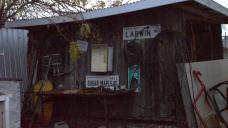
 iso 12800 before.jpg1920 x 1080 - 690K
iso 12800 before.jpg1920 x 1080 - 690K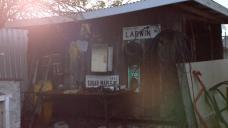
 iso 12800 fixed.jpg1920 x 1080 - 447K
iso 12800 fixed.jpg1920 x 1080 - 447K -
@balazer My understanding is that you're right for normal moving pictures, but noise (being random) is impossible to predict, hence looks uglier with higher GOPs. Or is that what you said anyway?
Don't know if I'm right but it makes sense in terms of the difference I see with all I-frames. It's sort of subtle but at the same time immediately noticeable when you have been used to the long GOP footage and for a given bitrate, looks better to me even if strictly speaking it's less efficient. -
@plasmasmp what do you mean by filtered up, is it noise reduction software?
-
the first video is amazing, but largely due to the fact that the guy used the voigtländer F0.95 lens :-D that thing is amazing!
-
@TraumManufaktur My two years of German didn't do much to help me with the dialog, but I liked the editing. :)
In response to what other considerations are helpful at high ISO, I would start by re-emphasizing what you said about over-exposure (especially when using Dynamic B&W), and also trying to avoid too much use of strong visible light sources in frame as they can really soften the image in an unintended way.
But the main thing I would say is to be judicious about evaluating the visual contrast in a scene before shooting and to be even more careful about focus than usual. It's very easy for things to end up looking too soft at high ISO, so you have to compensate by paying more attention than you normally would. There were a few shots in the video you posted that could have been improved by more tightly focusing on the subject of the shot.
When you shoot high ISO with the focus slightly off on the GH2, it starts to look "cheap". This isn't a flaw with the camera, just a fact of life in dealing with such things. But if you nail that focus (and try to really make good use of shadows and light sources) you can get a level of definition that doesn't draw attention to the acquisition method, and I think that's what a lot of us are looking for. :) -
@Mark_the_Harp, that's not what I'm saying. What I said is true regardless of the amount of noise.
A constant quality encoder applies the same level of quantization to every single block of every single frame, regardless of frame type. That means that you would not be able to tell the difference between an I-frame, P or B frame in the decoded picture, and you'd have no visible indication of the GOP length. Compression efficiency goes up when there is more similarity between frames and when the GOP is longer. If a video stream is pure noise, there is no similarity between frames, so using longer GOPs would give you no more efficiency: for some encoder output quality level, a GOP1 stream would have the same bit rate as GOP10. The encoded P and B frames would be the same size as the I-frames.
But the GH2 encoder isn't constant quality. It has all kinds of biases built into it, because it was designed to be variable within certain bit rate ranges, with certain GOP lengths and patterns. I haven't followed the development of the hacks in detail, but I'm guessing that it turned out to be impossible to get the GH2 to boost the sizes of its encoded P and B frames. To preserve the most quality under very noisy conditions, the P and B frames should be nearly as large as the I-frames, and the bit rate would go up accordingly.
Using all I-frames eliminates one component of an encoder's variable performance: now the encoder is doing nothing to try to find similarities between frames, so the amount of similarity no longer has any bearing on the encoder's compression efficiency. But even having eliminated one component of the encoder's variable performance, some frames are more compressible than other frames, so using all I-frames doesn't make the encoder constant quality. It just gets us closer, in some sense. And since the GH2 lets us write very large I-frames, we get high quality regardless of the amount of similarity between frames. That helps a lot with high ISOs.
Notice I didn't use the word "motion" anywhere in there. The encoder has a very limited notion of motion. Basically, when I said that the encoder looks for similarity between frames, similarity includes the case when an object visible in one frame is visible in another frame, but in a different position within the frame. The encoder is able to search for where the object moved to, and compensate for its motion when it builds the base frame that a P or B frame is encoded relative to. So when you hear people talk about encoder settings that are optimized for high motion, it's really not accurate. Motion is just one thing that can make two frames less similar even after compensation, and then only in specific cases, e.g. when new objects are moving into frame, or when an object has moved farther than the encoder is able to search for. -
@thepalalias Thanks for letting me down ez XD. Your suggestions are helpful. I liked the results outdoors, the facade and the chairs. Yeah, sharpness is an issue with these cafe concert setups. Specially the book reading and the audience reaction shots could have been much better. You're right, I'm striving to get results that don't draw attention to the acquisition. The Zoom 14-140 is much too slow in low-light. I felt like I was shooting Hi-8 back in the '90, now I know how to get that "look" today. wink
Quick & dirty, no post-process.
Here I tried the Canon FD 50.4 with better luck, of course with careful positioning, cause I'd be stuck in that corner. When I planned this new shoot there was a frontal light globe to balance the lamp behind the singer and all was beautiful. It's just when the concert started, the front light was turned off for "atmosphere", ack. Back came softness and focus issues. Perhaps I have to bring a rope light or a flashlight, to make some impromptu lighting. Well, I'll work it out, the process is fun. -
@danyyyel - "Just need for a hack to get the best Dynamic range from the sensor for the gh2 to be perfect. "
The downside to shooting at ISO 12800 is a dramatic reduction in dynamic range. This, along with its background noise, is an inherent aspect of the physical properties of the image sensor:
http://www.sensorgen.info/PanasonicDMC_GH2.html
At ISO 12800, the GH2 has only 5 stops of dynamic range, but as we see in the video samples in this thread, that's enough for low-light shooting. If you look at the Sensorgen link's Read Noise data, you may spot the GH2's saving grace: the sensor has only half as much random noise at ISO 12800 than at ISO 160! At the dark end of the dynamic range, this is equivalent to opening the lens aperture a full stop wider, making shadow detail significantly cleaner at ISO 12800.
With the limited dynamic range, however, you should be prepared to blow out the highlights whenever a direct source of illumination is in the frame. Black & white Film Modes can handle this more gracefully as there is no chance of color shift in the blown highlights. -
I shot all night scenes while in Rome with 12800 and seAQuake.. Bumped up contrast, dynamicBW. I noticed that when stopping down for brighter spots, (which could have been shot with 3200, 1600 or less) the noise was very, very clean. (which is true for basically the whole iso-range - well exposed shots do not produce bad noise) And the noise in poorly lit areas wasn't bad either, on the contrary.. The look is very interesting and I'm getting ideas for making a serious short with it.
Frame grab attached. Nothing done with it. It's not carefully selected or anything.. The existing light was minimal in this particular case.
The only thing I'd like to do in post is fix the occasional horizontal banding problem.. A tool to fix horizontal banding only (not grain / other noise) would be nice to have.
Basically, the most "problematic" areas are even midtones.. (that produces most noise, most banding a.s.o.)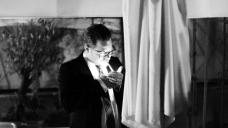
 BW12800iso.jpg1920 x 1080 - 1M
BW12800iso.jpg1920 x 1080 - 1M -
If you think those conditions are bad for low light, here's my night: shooting an interview with a homeless man, 10 minute hike away from my car, down the river near a bridge, with so little light from the nearest street illumination in some shots that I needed to shoot ISO 12,800 at 1/8 to get enough light.
That is until the shoot was interrupted by the sound of 5 bullets being fired in close proximity and we had to go silent until we could be sure the shooter had left. Oh, and then trying to get stills to from atop a bridge to see whether a particular shape was a log or a dead body...
I think I'll go back to worrying about poorly controlled lighting in a nice room again, thank you very much. :)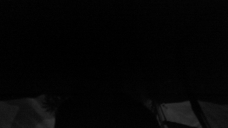
 ISO 12,800 shutter 1 over 50.png1920 x 1080 - 1M
ISO 12,800 shutter 1 over 50.png1920 x 1080 - 1M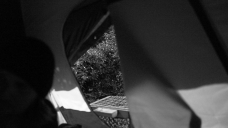
 ISO 12,800 shutter 1 over 2.png1920 x 1080 - 1M
ISO 12,800 shutter 1 over 2.png1920 x 1080 - 1M
Start New Topic


Howdy, Stranger!
It looks like you're new here. If you want to get involved, click one of these buttons!
Categories
- Topics List23,993
- Blog5,725
- General and News1,354
- Hacks and Patches1,153
- ↳ Top Settings33
- ↳ Beginners256
- ↳ Archives402
- ↳ Hacks News and Development56
- Cameras2,368
- ↳ Panasonic995
- ↳ Canon118
- ↳ Sony156
- ↳ Nikon96
- ↳ Pentax and Samsung70
- ↳ Olympus and Fujifilm102
- ↳ Compacts and Camcorders300
- ↳ Smartphones for video97
- ↳ Pro Video Cameras191
- ↳ BlackMagic and other raw cameras116
- Skill1,960
- ↳ Business and distribution66
- ↳ Preparation, scripts and legal38
- ↳ Art149
- ↳ Import, Convert, Exporting291
- ↳ Editors191
- ↳ Effects and stunts115
- ↳ Color grading197
- ↳ Sound and Music280
- ↳ Lighting96
- ↳ Software and storage tips266
- Gear5,420
- ↳ Filters, Adapters, Matte boxes344
- ↳ Lenses1,582
- ↳ Follow focus and gears93
- ↳ Sound499
- ↳ Lighting gear314
- ↳ Camera movement230
- ↳ Gimbals and copters302
- ↳ Rigs and related stuff273
- ↳ Power solutions83
- ↳ Monitors and viewfinders340
- ↳ Tripods and fluid heads139
- ↳ Storage286
- ↳ Computers and studio gear560
- ↳ VR and 3D248
- Showcase1,859
- Marketplace2,834
- Offtopic1,320










